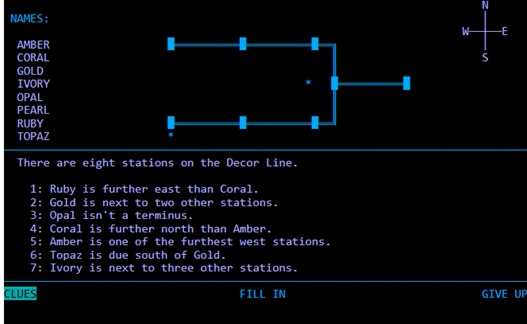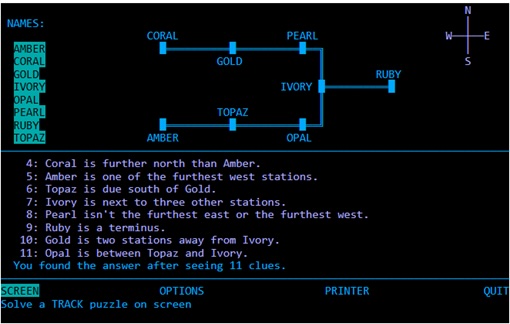ABSTRACT: This paper, originally presented to a regional meeting in December 1990 but heavily revised since, describes the structure of a set of computer logic puzzle generators. The puzzle format demands that the learner think about meaning while being exposed to a set of sentences displaying the same or similar sentence patterns; hence the description “receptive drill.”
Receptive drill may sound like a contradiction in terms, since drill is something we associate with repetitive actions on military parade grounds or in gymnasiums. The repetition turns the actions into habits, carried out without conscious thought. Applied to education, drill fits into a behaviourist theory which thinks of skills as behaviour that can be moulded by rewards and punishments. We remember Pavlov’s dogs or Skinner’s pigeons. Applied to language learning, drill was a model that fitted in not just with the theory but with the emerging technology of the language laboratory after WW II, which matched the emergence of “programmed learning”, the breaking up of a topic or task into a set of very small steps which could be presented one frame at a time with confirmation after each frame. A major element of the material developed for laboratories in the early days was sets of sentences to be made by making small changes to a sentence frame:
| Can you tell me the way to the | post office? |
| station? | |
| airport? | |
| etc |
often a lengthy sequence of them. This was often labelled “drill-and-practice” or with more hostility “drill-and-kill”. The drawback of these materials was that they could be carried out without giving any thought to meaning, creating what Julian Dakin called “the tum-ti-tum effect”, which led Dakin to caution teachers against thinking that learners uttering meaningful-sounding sentences in a language they are learning are “speaking” the language (Dakin, 1973). On the other hand, repetition may be desirable or necessary for a language learner; I made a point of telling my classes that they would never learn a new word or idiom from one exposure—they would probably need twenty. This was also brought home to me when trying to learn Serbian (or Serbo-Croatian as we used to call it in those days) with a private tutor before my British Council appointment to Belgrade. I was bright enough to answer most of her questions correctly and had enough phonetic training to imitate her with a good accent. She assumed a correctly pronounced right answer showed that I knew whatever she was presenting and would keep jumping ahead. I had to plead with her: “No, I haven’t learned that yet. Give me some drill.”
However, there is another way of ensuring that learners see or hear new sentences or sentence patterns and that they think about the meanings as well as the forms. You simply ask the learner to make an inference or carry out a small calculation. For instance, the learner sees or hears
|
The office opens at ten. You will have to wait for twenty minutes. We open at six. Come back in ten minutes. The manager arrives at nine. You are quarter of an hour early. You’re ten minutes late. We opened at twelve. The train is due at ten fifteen. You have ten minutes to wait. |
In each case the task is to work out what the time is now and write it down or display it on a cardboard clockface. This was a technique that was pioneered by Colin Mortimer who worked in Thailand in the 1970s and wrote a remarkable set of listening materials using these principles for students at Chulalongkorn University.
Another way of ensuring repeated exposure to a language item or grammar pattern is to make use of logic puzzles, small tasks which present simple language clues from which inferences have to be drawn. It is a straightforward task to write computer software which can generate a vast number of puzzles, each trivially different but setting a problem to be solved. One advantage is that the presentation can be via screen and keyboard or in the form of paper puzzles. In this example called TRACK, a map of a suburban railway line is shown and the task is to put the right station names on the map.

The clues take the form
|
X is further/due north/south/east/west of Y. X is two stations away from Y. X is between Y and Z. X is/is not a terminus. X is/is not on the northern/southern branch.. X is/is not next to one/two/three other stations |
The program displays an asterisk at a station when it has shown enough information for the user to identify it.

Now one more clue will provide enough information for a complete solution:

The puzzle can be solved at the screen and keyboard, or a complete set of clues can be printed out, since the program itself can determine how many are needed.
This was one of a set of logic puzzles developed at Stirling University as one element in English courses for overseas students. The clues are presented as text, but the learners' task is to understand the text and translate it into some non-linguistic representation so that inferences can be drawn. In the process learners are exposed to text but are concentrating on meaning rather than on the linguistic forms. Moreover, if the task is turned into a group activity, a great deal of spoken language occurs incidentally, especially if the participants each receive only some of the clues and have to ask questions or read aloud their own clues in order to share information. This is very much in tune with current language learning pedagogy, which emphasises the role of meaning in the learning process and the value of creating an 'information gap' so that communication is necessary for some reason other than the teacher's say-so.
Other puzzles that we developed were:
Six outlines of children are shown at the top of the screen and a seesaw in the middle. One child is labelled with a weight. By convention weights are in multiples of 5 lbs in the range 50 lbs to 90 lbs. Users place the children on the seesaw by responding to the prompts "Who is on the left?" or "Who is on the right?" pressing appropriate initials. The program then moves the child to the seesaw, which goes up or down, at the same time printing a message of the form Ben weighs a little more than Alice. Cora and Dick weigh less than Edward and Fiona. "A little more/less" implies a difference of 5 or 10 lbs, while "more/less" implies 15 or 20 lbs, and "a lot more/less" 25+ lbs. The children can be weighed in any combinations and any number of times in order to work out the missing weights.
A Venn diagram of three overlapping circles representing a population. The computer prints an initial statement of the form Out of 54 energetic students, 45 played squash, rugby and/or tennis. and then offers clues of the form 3 more students played only squash than played rugby and squash (but not tennis). 24 students altogether played rugby. 27 students did not play tennis. In the interactive form the players can fill in the number in any segment of the diagram whenever they think they know it. In the paper form a sufficiency of clues is printed out. TRIP: Users see a blank diary page covering one week and a list of towns representing a tourist group's itinerary. Clues take the form They went to Guildford before they went to Bath. Their postcards of Brighton had a Bristol postmark. They didn't go to Oxford on a weekday. Their visit to Cambridge was during the first three days. Users enter the towns against the days when they have seen enough information.
Users see a schematic map of a crossroads. Clues take the form: … If you approach the junction from the south, you have two choices. … Coming from the west you had better not turn left or you will be arrested. … King Street East is a one-way street. … You cannot drive south on Main Street South. Users mark the map with one-way arrows and no-entry signs when they have enough information.
In addition we made use of the clock activity described above and a similar exercise for days of the week which I developed in Belgrade. The puzzles themselves are not usually of great difficulty; after all they were designed for people with only an intermediate command of English. Each puzzle has a linguistic focus so that a teacher can tie them into a syllabus or draw attention to some point of usage when the activity is over. In this sense TRACK, for example, is about prepositions and compass directions; CARFAX is about modal verbs; TRIP is about past tenses; INVENNTION is about numeric comparison, while SEESAW and TWO STICKS are about size comparison. The CLOCK activity is of course about time, while various versions of my SERBDAYS are about days of the week.
Using a computer to create the puzzles has the great advantage that a number of near replicas of a basic puzzle form can be created with almost no effort beyond writing the initial program. Almost all the programs are written so that the output may be a paper puzzle sent straight to the printer or an interactive puzzle to be solved piecemeal by calling up clues on screen, keying in partial answers and getting feedback. Where a set of clues is printed, it is straightforward to cut up the clues and distribute them to a group of students, each student then having charge of a clue or clues to read out so that the puzzle is solved collaboratively. Apart from the central logic, each program consists of a set of display routines which print out an attractive screen or page to give the context of the puzzle, and the necessary interactive routines to get and interpret the user's key presses. The programs each draw on a stored set of scenarios, ie sets of personal or place names, so that consecutive runs are different. In programming terms drawing the screens, designing menus and input routines, and choosing the scenarios are all relatively trivial tasks, but it is well worth taking care over them in order to make the user's task as easy as possible and to ensure that good design principles are followed. These elements probably account for well over half the time and effort that go into the creation of the programs.
So far I have not had an opportunity to measure the benefit of logic puzzles on the acquisition of grammar structures by means of a systematic trial. However, the programs have gone down well with their initial target audience, and I like to think that several classes of North African students have been introduced to an experience they might not otherwise have had and appear to have relished it.
The TRACK puzzle, incidentally, was taken up in the 1990s by Loughborough University for a study of mental performance under conditions of sleep deprivation. I was asked to create a version of the software with comprehensive record-keeping facilities, which was then administered to a population under varied degrees of tiredness. The results, however, were not relevant to me as the subjects were first-language speakers, and I never saw the final report.